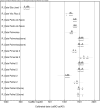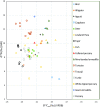Late Holocene dietary and cultural variability on the Xingu River, Amazon Basin: A stable isotopic approach
- PMID: 35921285
- PMCID: PMC9348659
- DOI: 10.1371/journal.pone.0271545
Late Holocene dietary and cultural variability on the Xingu River, Amazon Basin: A stable isotopic approach
Abstract
Although once considered a 'counterfeit paradise', the Amazon Basin is now a region of increasing interest in discussions of pre-colonial tropical land-use and social complexity. Archaeobotany, archaeozoology, remote sensing and palaeoecology have revealed that, by the Late Holocene, populations in different parts of the Amazon Basin were using various domesticated plants, modifying soils, building earthworks, and even forming 'Garden Cities' along the Amazon River and its tributaries. However, there remains a relatively limited understanding as to how diets, environmental management, and social structures varied across this vast area. Here, we apply stable isotope analysis to human remains (n = 4 for collagen, n = 17 for tooth enamel), and associated fauna (n = 61 for collagen, n = 28 for tooth enamel), to directly determine the diets of populations living in the Volta Grande do Rio Xingu, an important region of pre-Columbian cultural interactions, between 390 cal. years BC and 1,675 cal. years AD. Our results highlight an ongoing dietary focus on C3 plants and wild terrestrial fauna and aquatic resources across sites and time periods, with varying integration of C4 plants (i.e. maize). We argue that, when compared to other datasets now available from elsewhere in the Amazon Basin, our study highlights the development of regional adaptations to local watercourses and forest types.
Conflict of interest statement
The authors have declared that no competing interests exist.
Figures







Similar articles
-
Stable isotope evidence for pre-colonial maize agriculture and animal management in the Bolivian Amazon.Nat Hum Behav. 2025 Mar;9(3):464-471. doi: 10.1038/s41562-024-02070-9. Epub 2024 Dec 23. Nat Hum Behav. 2025. PMID: 39715871 Free PMC article.
-
Stable isotope evidence for dietary diversification in the pre-Columbian Amazon.Sci Rep. 2020 Oct 6;10(1):16560. doi: 10.1038/s41598-020-73540-z. Sci Rep. 2020. PMID: 33024191 Free PMC article.
-
Fruits of the forest: Human stable isotope ecology and rainforest adaptations in Late Pleistocene and Holocene (∼36 to 3 ka) Sri Lanka.J Hum Evol. 2017 May;106:102-118. doi: 10.1016/j.jhevol.2017.01.015. Epub 2017 Mar 21. J Hum Evol. 2017. PMID: 28434535
-
Dietary shifts and diversities of individual life histories reveal cultural dynamics and interplay of millets and rice in the Chengdu Plain, China during the Late Neolithic (2500-2000 cal. BC).Am J Phys Anthropol. 2021 Aug;175(4):762-776. doi: 10.1002/ajpa.24259. Epub 2021 Feb 27. Am J Phys Anthropol. 2021. PMID: 33638171
-
The legacy of cultural landscapes in the Brazilian Amazon: implications for biodiversity.Philos Trans R Soc Lond B Biol Sci. 2007 Feb 28;362(1478):197-208. doi: 10.1098/rstb.2006.1979. Philos Trans R Soc Lond B Biol Sci. 2007. PMID: 17255029 Free PMC article. Review.
Cited by
-
Stable isotope evidence for pre-colonial maize agriculture and animal management in the Bolivian Amazon.Nat Hum Behav. 2025 Mar;9(3):464-471. doi: 10.1038/s41562-024-02070-9. Epub 2024 Dec 23. Nat Hum Behav. 2025. PMID: 39715871 Free PMC article.
-
South American Archaeological Isotopic Database, a regional-scale multi-isotope data compendium for research.Sci Data. 2024 Apr 4;11(1):336. doi: 10.1038/s41597-024-03148-9. Sci Data. 2024. PMID: 38575659 Free PMC article.
References
-
- Koch A, Brierleya C, Maslina MM, Lewis SL. Earth system impacts of the European arrival and Great Dying in theAmericas after 1492. Quaternary Science Reviews, 207. 2019: p. 13–36.
-
- Meggers BJ. Environmental limitation on the development of culture. American Anthropology. 1954; 56(5): p. 801–824.
-
- Meggers BJ. Amazônia: a ilusão de um paraíso. Rio de Janeiro: Civilização Brasileira; 1977.
-
- Bailey RC, Head G, Jenike M, Owen B. Hunting and Gathering in Tropical Rain Forest: Is it Possible? American Anthropology. 1989; 91(1): p. 59–82.
-
- Clement CR, Cristo-Araújo M, d’Eeckenbrugge GC, Pereira AA, Picanço-Rodrigues D. Origin and Domestication of Native Amazonian Crops. Diversity 2010. 2010: p. 72–106.
Publication types
MeSH terms
Substances
LinkOut - more resources
Full Text Sources
Miscellaneous

